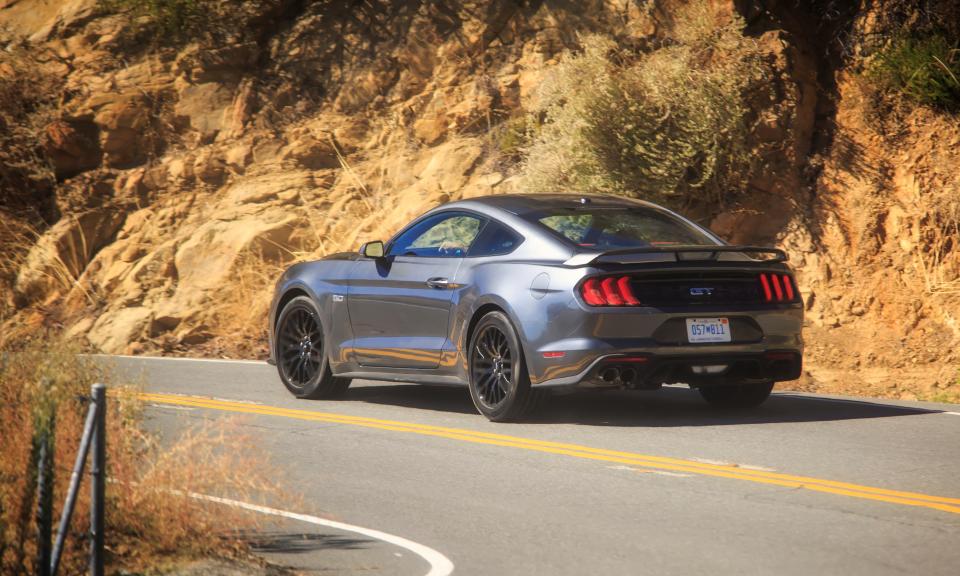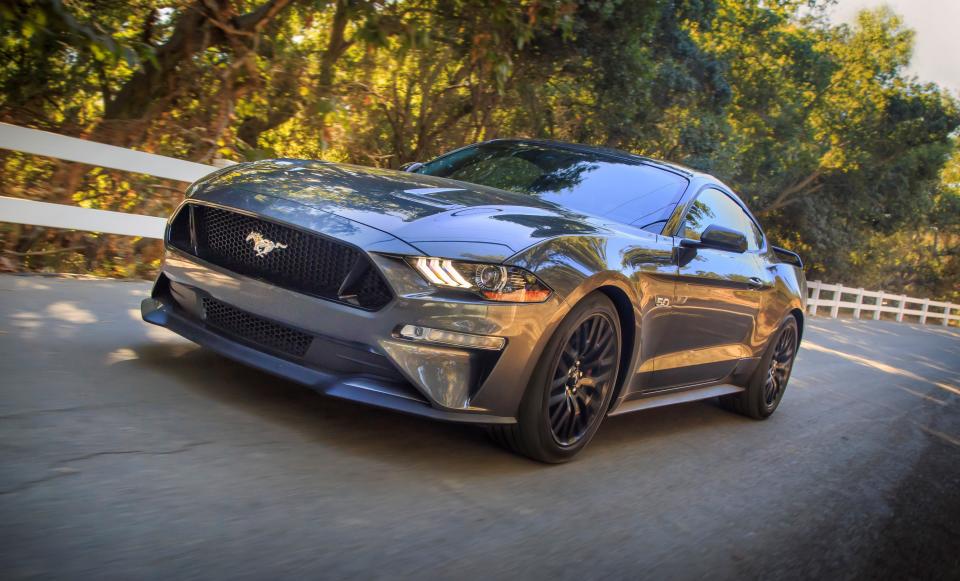2018 Ford Mustang GT: First Drive

It’s still a Mustang. With the exception of the bastardized Pinto that became the Mustang II, Ford’s pony car hasn’t strayed from the original blend of herbs and spices that made it a hit in 1965. Now we're getting into the meat of the 21st century and the 2018 Ford Mustang continues to offer a V-8, rear-wheel drive, two doors, and a manual transmission. It still looks the business too, even though the 2018 may look a little beady eyed.
But there's no shrinkage under the hood of the GT models. A 0.8-mm larger bore, a result of the switch from cylinder liners to a spray-in coating, raises displacement from 4970 cc to 5030 cc. Don’t worry, you’ll still be rolling in a 5.0. On top of the block are new cylinder heads with port and direct injection. The new heads raise the compression ratio from 11:1 to 12:1 and two additional knock sensors - three total - more closely manage detonation. Power rises from 420 horsepower to 460, five more than the Camaro’s 6.2-liter V-8. Torque goes from 400 pound-feet to 420, 40 fewer than the Camaro. The redline is up 500 rpm to 7500. At the bottom end, the oil pan is now plastic, which saves 4.9 pounds.

Next to the GT350’s flat-plane 5.2 liter V-8, the GT’s cross-plane 5.0 is an altogether mellower engine. From idle to redline there’s never any harshness, just the familiar rumbles and murmurs of a traditional V-8. A new active exhaust system is optional ($895) and has four settings to tailor its personality to your mood. In Quiet mode the exhaust still belts out the hits, but from behind the wheel you hear the engine up front more so than behind. Each successive step from Normal to Sport to Track twists the volume knob and makes the 5.0 more obnoxious or delightful depending on your point of view. Ford has even put in a Quiet Start feature that keeps the engine from waking the neighborhood when you fire up your Mustang up at 6 AM.
A new 10-speed automatic replaces last year’s six-speed. Shifts are quick and the box is remarkably astute when put into Sport mode. Paddle shifters on the steering column give the driver ultimate control, but the auto is smart enough to downshift and give you the correct gear for corner entry and exit. That said, more than half of GT customers go for the six-speed manual. We’d do the same, even if the automatic proves to be quicker to 60 mph.

We’d also go for the $3995 Performance package that adds staggered Michelin Pilot Sport 4S summer rubber on 19-inch wheels, a limited-slip differential, six-piston front calipers (up from four-piston), additional bracing in the front end, and a different chassis setup to complement the sticky Michelins. Magnetorheological shocks ($1695) become available with the Performance package. In front the magnetic shocks are an inverted strut to increase stiffness. All of the GTs we tested were equipped with the MagneRide shocks, which have four settings (Normal, Sport, Track, and Drag). Normal through track up the damping forces and sensitivity to wheel motion, Drag mode softens the rear shocks relative to the fronts to allow the car to transfer its weight more effectively on a launch.
The body-tossing grip from the new Michelins makes us wish Ford made the $1595 Recaros standard with the Performance package. The electric power steering system lacks the directness and turn-in eagerness of the GT350’s setup, but the GT is edging closer. Body motions are tightly controlled and the brakes have a firm and responsive pedal. In March, Ford will offer a Level Two Performance package that sets its sights on the Camaro SS 1LE. Level Two will give the GT an even more aggressive chassis tune with 305/30R19 Michelin Pilot Sport Cup 2 from the GT350R.
On the other end of the Mustang spectrum, the V-6 is dead which leaves the turbocharged 2.3-liter four-cylinder as the only other engine option. Output remains 310 horsepower, but torque is up to 350 pound-feet on overboost and available in 20-second bursts. A six-speed manual is standard and the 10-speed automatic is optional. The turbo four provides good power, but it’s a tough sell after driving the V-8. You can also get it with a $2495 Performance package that bundles the base GT’s four-piston calipers with Pirelli P Zero summer tires and a retuned suspension.

A newly available 12-inch digital instrument cluster is the major news inside. Configurable in three ways, the display looks great, but it’s only available on the top-spec GT Premium model.
Even though the Mustang handily outsells the Camaro, Ford’s chassis alterations show that the Camaro’s handling and track prowess hasn’t gone unnoticed in Dearborn. The ’18 model inches closer to its GT350 brother in power, handling, and price. With the Performance package, Magnetorheological shocks, active exhaust, and Recaro seats a Mustang GT coupe will push $50,000 or nearly double the $26,485 price of a base Mustang. Avoiding the Premium trim level makes a GT with all the handling goodies cost less than $45,000. It’s not a coincidence that price lines up with the $44,995 price of the Camaro SS 1LE.
You Might Also Like

 Yahoo Autos
Yahoo Autos 